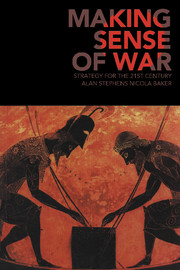Book contents
- Frontmatter
- Contents
- Abbreviations
- Preface
- Introduction
- Chapter 1 How to win
- Chapter 2 Stove-piped strategy
- Chapter 3 Traditional warfighting concepts and practices
- Chapter 4 Manoeuvre and the application of force
- Chapter 5 Shaping the strategic environment
- Chapter 6 Strategic paralysis
- Chapter 7 Contemplating war
- Chapter 8 Constraints on war
- Chapter 9 Controlling war
- Chapter 10 Peacemaking
- Chapter 11 War in the twenty-first century
- Notes
- Select bibliography
- Index
Chapter 2 - Stove-piped strategy
The schools of strategic thought
Published online by Cambridge University Press: 05 June 2012
- Frontmatter
- Contents
- Abbreviations
- Preface
- Introduction
- Chapter 1 How to win
- Chapter 2 Stove-piped strategy
- Chapter 3 Traditional warfighting concepts and practices
- Chapter 4 Manoeuvre and the application of force
- Chapter 5 Shaping the strategic environment
- Chapter 6 Strategic paralysis
- Chapter 7 Contemplating war
- Chapter 8 Constraints on war
- Chapter 9 Controlling war
- Chapter 10 Peacemaking
- Chapter 11 War in the twenty-first century
- Notes
- Select bibliography
- Index
Summary
THE STUDY OF strategic thinking traditionally has been conducted by dividing the topic by environment or nature into a number of schools of thought, the most common of which are the continental, maritime, air, nuclear, guerilla, and terrorist. One consequence of this has been a tendency for strategy to evolve within the mutually exclusive environmental stove-pipes of land, sea and air. But because advanced nations now almost invariably conduct warfare – and therefore the development of strategies and the planning of operations – with joint forces, which are intended to function as an integrated whole rather than as three distinct environmental entities, this approach has become somewhat artificial. The different mediums in which armies, navies and air forces operate may induce their leaders to adopt different tactics and to develop distinctive cultures, but ultimately all of those means must be applied through a common strategy to achieve the desired outcome.
Nevertheless, placing boundaries around a subject as complex as strategy is a useful way of keeping the material under control and assisting understanding. Furthermore, the fact is that until air forces started to appear in the early twentieth century, armies and navies generally conducted their operations separately; that is, genuine joint warfare scarcely existed. And the rise of terrorism as a preferred method of coercion has meant that, of the six schools, it at least can still be identified as a discrete method of operations, albeit one proscribed by international law.
- Type
- Chapter
- Information
- Making Sense of WarStrategy for the 21st Century, pp. 14 - 33Publisher: Cambridge University PressPrint publication year: 2006

